PH/ORP Sensor Guide
Learn about pH and ORP in this guide, including: how pH/ORP probes work, how to interface with pH/ORP probes, how to care for probes, and more.

Quantity Available: 888
| Qty | Price |
|---|---|
| 10 | $26.60 |
| 25 | $23.80 |
| 50 | $21.00 |
| 100 | $19.60 |
The pH Phidget is a pH/ORP interface. It measures the signal from a pH/ORP electrode and provides a clean, stable digital reading for your application.
After connecting the interface to a computer through a VINT Hub Phidget, you can measure one electrode. Measurements can be returned as a pH value, or as a voltage.
The pH Phidget features an isolated input, which may result in more stable and accurate readings.
The ADP1000 with a pH or ORP probe measures pH (0-14) or gets raw voltage input from the probe (±400mV or ±2V). For more accuracy, set the temperature of the solution in the software.
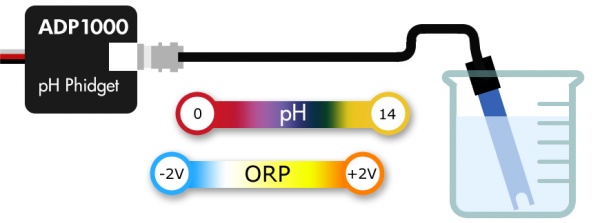
You can use your Control Panel to explore your Phidget's channels.
1. Open your Control Panel, and you will find the following channels:
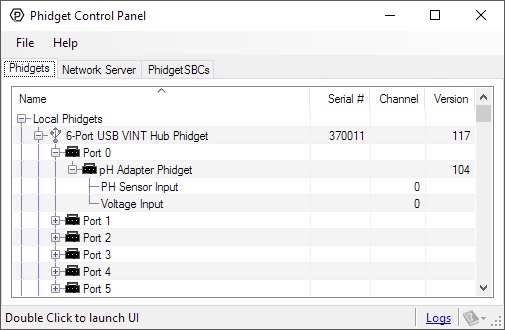
2. Double click on a channel to open an example program. Each channel belongs to a differemt channel class:
In your Control Panel, double click on "PH Sensor Input":
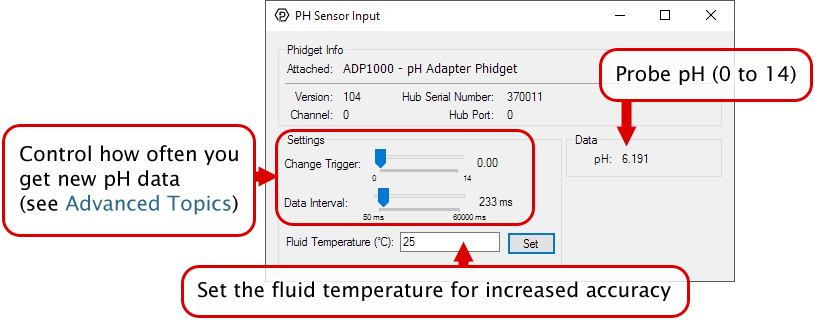
In your Control Panel, double click on "Voltage Input":

Before you open a Phidget channel in your program, you can set these properties to specify which channel to open. You can find this information through the Control Panel.
1. Open the Control Panel and double-click on the red map pin icon:

2. The Addressing Information window will open. Here you will find all the information you need to address your Phidget in your program.

See the Phidget22 API for your language to determine exact syntax for each property.
Note: Graphing and logging is currently only supported in the Windows version of the Phidget Control Panel.
In the Phidget Control Panel, open the channel for your device and click on the ![]() icon next to the data type that you want to plot. This will open up a new window:
icon next to the data type that you want to plot. This will open up a new window:
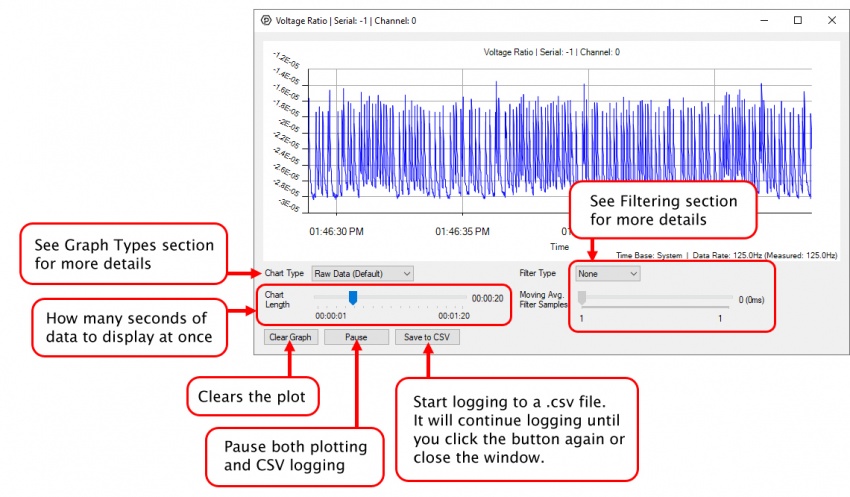
If you need more complex functionality such as logging multiple sensors to the same sheet or performing calculations on the data, you'll need to write your own program. Generally this will involve addressing the correct channel, opening it, and then creating an Event Handler and adding graphing/logging code to it.
The quickest way to get started is to download some sample code for your desired programming language and then search google for logging or plotting in that language (e.g. "how to log to csv in python") and add the code to the existing change handler.
You can perform filtering on the raw data in order to reduce noise in your graph. For more information, see the Control Panel Graphing page.
You can perform a transform on the incoming data to get different graph types that may provide insights into your sensor data. For more information on how to use these graph types, see the Control Panel Graphing page.
The Change Trigger is the minimum change in the sensor data needed to trigger a new data event.
The Data Interval is the time (in ms) between data events sent out from your Phidget.
The Data Rate is the reciprocal of Data Interval (measured in Hz), and setting it will set the reciprocal value for Data Interval and vice-versa.
You can modify one or both of these values to achieve different data outputs. You can learn more about these properties here.
Firmware Upgrade
MacOS users can upgrade device firmware by double-clicking the device row in the Phidget Control Panel.
Linux users can upgrade via the phidget22admin tool (see included readme for instructions).
Windows users can upgrade the firmware for this device using the Phidget Control Panel as shown below.
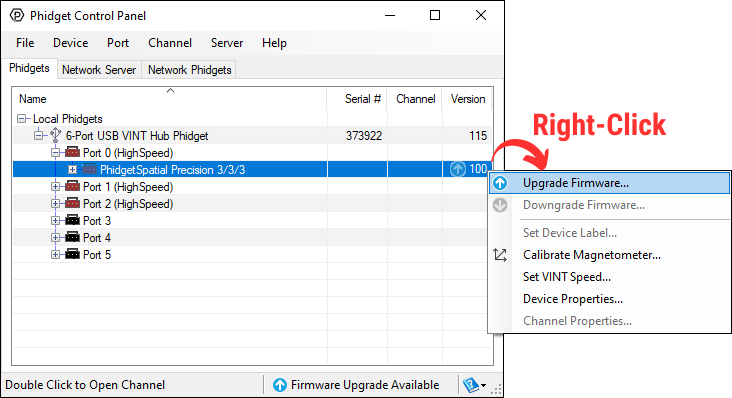
Firmware Downgrade
Firmware upgrades include important bug fixes and performance improvements, but there are some situations where you may want to revert to an old version of the firmware (for instance, when an application you're using is compiled using an older version of phidget22 that doesn't recognize the new firmware).
MacOS and Linux users can downgrade using the phidget22admin tool in the terminal (see included readme for instructions).
Windows users can downgrade directly from the Phidget Control Panel if they have driver version 1.9.20220112 or newer:
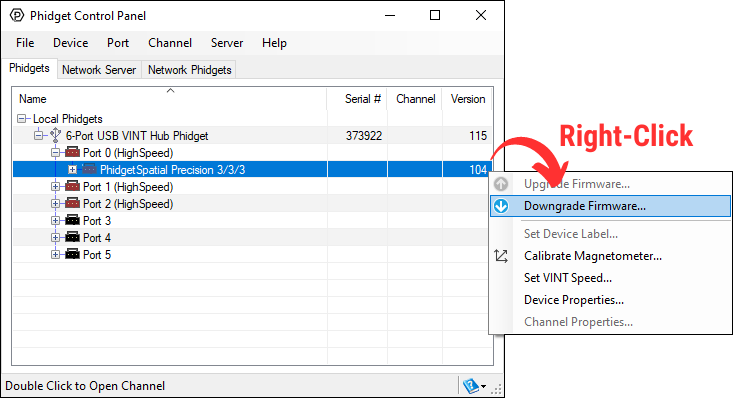
Firmware Version Numbering Schema
Phidgets device firmware is represented by a 3-digit number. For firmware patch notes, see the device history section on the Specifications tab on your device's product page.
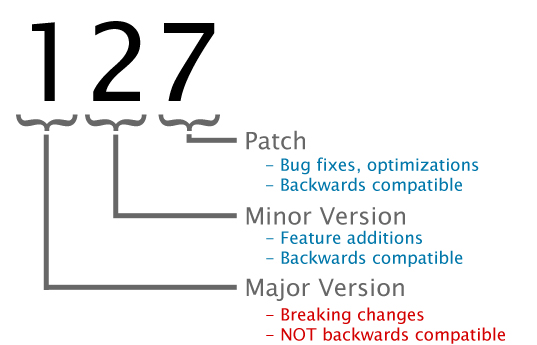
The ADP1000 automatically converts raw voltage (from the pH probe) into an extremely accurate pH reading. For even more accuracy, you can set a Correction Temperature. The Correction Temperature corresponds to the temperature of the solution you are measuring (in °C). Here are a few examples of how temperature affects the output voltage of a pH probe:
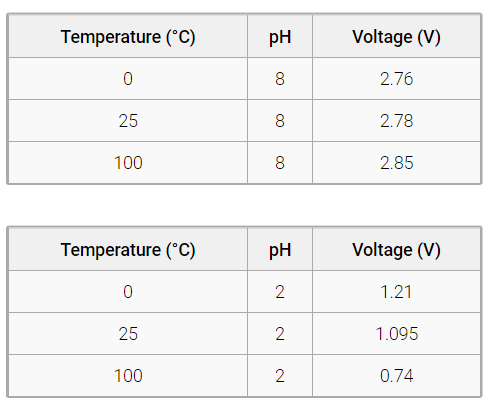
As you can see from the examples above, temperature has a greater impact on solutions that have a pH further away from 7.
If you want to monitor the temperature of your solution, you can use a thermocouple. Check out our Thermocouple Interfaces to get started. For more information about how to set a Correction Temperature, view the Phidget22 API.
When the probe dries out, it becomes more sensitive to interference. Even static electricity on your clothes can warp the reading. To solve the problem, immerse the probe in a buffer solution overnight.
See the PH/ORP Sensor Guide for more information.
| Sensor Properties | |
|---|---|
| Controlled By | VINT |
| VINT Communication Speed Max | 10 kbit/s |
| ±400mV Range | |
| Voltage Resolution | 40 μV DC |
| Measurement Error Max | ± 0.1 % |
| Sampling Interval Max | 60 s/sample |
| Sampling Interval Min | 50 ms/sample |
| Voltage Noise | 65 μV DC |
| PHSensor Mode | |
| pH Resolution | 0.0007 |
| Measurement Error Max | ± 0.1 % |
| Sampling Interval Max | 60 s/sample |
| Sampling Interval Min | 50 ms/sample |
| pH Noise | 0.0011 |
| ±2V Range | |
| Voltage Resolution | 200 μV DC |
| Measurement Error Max | ± 0.5 % |
| Sampling Interval Max | 60 s/sample |
| Sampling Interval Min | 50 ms/sample |
| Voltage Noise | 235 μV DC |
| Voltage Sensor | |
| Sensor Input Impedance | 1 TΩ |
| Number of Voltage Inputs | 1 |
| Electrical Properties | |
| Current Consumption Min | 6 mA |
| Current Consumption Max | * 10 mA |
| Isolation Voltage (DC) | 3.8 kV DC |
| Physical Properties | |
| Operating Temperature Min | -40 °C |
| Operating Temperature Max | 85 °C |
| Customs Information | |
| Canadian HS Export Code | 8471.80.00 |
| American HTS Import Code | 8471.80.40.00 |
| Country of Origin | CN (China) |
* - Varies depending on selected data interval. See the graph below for details.

| Date | Board Revision | Device Version | Comment |
|---|---|---|---|
| June 2017 | 0 | 104 | Product Release |
| March 2022 | 0 | 105 | Added 50/60Hz filter to deal with common mains power noise |
| Channel Name | API | Channel |
|---|---|---|
| PH Sensor Input | PHSensor | 0 |
| Voltage Input | VoltageInput | 0 |
| API | Detail | Language | OS | |
|---|---|---|---|---|
| PHSensor | Objective-C | macOS | Download | |
| PHSensor | Swift | macOS | Download | |
| PHSensor | Swift | iOS | Download | |
| PHSensor | Visual Basic | Windows | Download | |
| PHSensor | Max | Multiple | Download | |
| VoltageInput | Visual Studio GUI | C# | Windows | Download |
| VoltageInput | Objective-C | macOS | Download | |
| VoltageInput | Swift | macOS | Download | |
| VoltageInput | Swift | iOS | Download | |
| VoltageInput | Visual Basic | Windows | Download | |
| VoltageInput | Max | Multiple | Download |
This Phidget is a smart device that must be controlled by a VINT Hub. For more information about VINT, have a look at the VINT Overview page. You can use a Phidget Cable to simply and easily connect the two devices. Here's a list of all of the different VINT Hubs currently available:
| Product | Board Properties | |||
|---|---|---|---|---|
| Part Number | Price | Number of VINT Ports | VINT Communication Speed Max | Controlled By |
 VINT Hub Phidget
|
$40.00 | 6 | 1 Mbit/s | USB (Mini-USB) |
 1-Port VINT Hub Phidget
|
$26.00 | 1 | 1 Mbit/s | USB (USB-A) |
 VINT Hub Phidget
|
$35.00 | 6 | 1 Mbit/s | USB (Mini-USB) |
 Wireless VINT Hub
|
$65.00 | 6 | 100 kbit/s | Local Network (Ethernet or Wi-Fi) |
 PhidgetSBC4
|
$130.00 | 6 | 100 kbit/s | — |
Use a Phidget cable to connect this device to the hub. You can solder multiple cables together in order to make even longer Phidget cables, but you should be aware of the effects of having long wires in your system.
| Product | Physical Properties | |
|---|---|---|
| Part Number | Price | Cable Length |
 Phidget Cable 10cm
|
$1.50 | 100 mm |
 Phidget Cable 30cm
|
$1.75 | 300 mm |
 Phidget Cable 60cm
|
$2.00 | 600 mm |
 Phidget Cable 60cm
|
$2.00 | 600 mm |
 Phidget Cable 90cm
|
$2.00 | 900 mm |
 Phidget Cable 120cm
|
$2.25 | 1.2 m |
 Phidget Cable 150cm
|
$2.50 | 1.5 m |
 Phidget Cable 180cm
|
$2.75 | 1.8 m |
 Phidget Cable 350cm
|
$3.00 | 3.5 m |
 Phidget Cable Kit
|
$10.00 | 80 mm |
 Phidget Cable Extension Wire 22AWG
|
$0.75/Meter | — |
The Phidgets pH/ORP Adapter can connect to one pH or ORP electrode that uses a BNC connector. The electrodes in the table below are all compatible with this adapter. If you plan on using your own electrode, we recommend that you contact Phidgets Support to determine if it will be compatible with this adapter.
| Product | Electrode Properties | Physical Properties | ||
|---|---|---|---|---|
| Part Number | Price | Electrode Type | Operating Temperature Max | Exterior Tube Material |
 pH Lab Electrode
|
$25.00 | Combination Single-Junction (pH) | 80 °C | Impact Resistant Plastic |